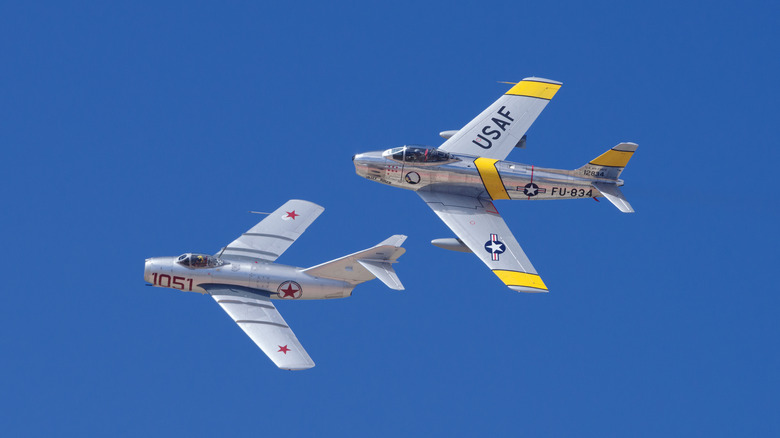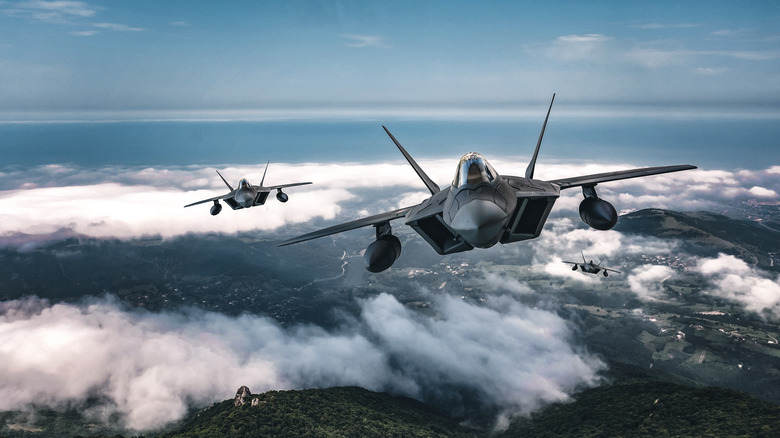What Is An Interceptor And How Does It Differ From A Fighter Jet?
Modern military fighter planes today are built with versatility in mind. It's more cost-effective and efficient to have one plane that serves multiple roles, but it wasn't always that way. The interceptor is an old-school military jet built for one thing: to intercept and destroy incoming enemy aircraft, especially bombers and reconnaissance-type aircraft. Standard fighters are universally designed for speed, agility, and balance to achieve mission flexibility; on the other hand, interceptors focus on speed, climb rate, and are equipped with long-range missiles to eliminate targets before contact is even made.
Interceptors were first used in World War I to shoot down Zeppelins and bombers. When radar was introduced in the 1930s and 40s, it helped interceptors become more lethal by enhancing early detection, so it had more time to climb and engage enemy targets. The MiG-25, F-106 Delta Dart, and the English Electric Lightning are examples of the classics that were intended to thwart bomber Cold War threats. Modern jets like the MiG-31 and the F-22 Raptor are not dedicated interceptors but still act in that role when necessary.
Key differences between interceptors and standard fighter jets
During the Cold War, interceptors served as a deterrent to nuclear-armed bombers and were built for extreme speed and high altitudes, with models like the MiG-25 capable of reaching Mach 2.8 or 2148 mph. Aside from extreme speed, less focus on maneuverability, and an intense rate of climb, the biggest difference between interceptors and other fighter jets is its limited weapons loadout. The interceptor's objective is to strike quickly and as fast as possible. To accomplish this, it's loaded with beyond visual range (BVR) missiles optimized for long-range kills, instead of close-quarter combat weapons, like the infrared-guided AIM-9 Sidewinder missiles used in dogfights.
Standard air superiority fighters are more equipped to handle aerial combat, engineering, and weapons-wise, balancing speed, maneuverability, payload, and endurance to maintain air dominance. These jets often operate in a group on aerial combat patrols and are meant to protect a territory by engaging single or multiple enemy aircraft in a no-fly zone. Examples of standard fighters are the F-15 Eagle and Su-27 Flanker.
How many dedicated interceptors remain, and are they still relevant?
After the Cold War, dedicated interceptors pretty much disappeared in favor of more multifaceted planes that could also fulfill that role. The U.S. retired its Convair F-106 Delta Dart in the 1980s, its last dedicated interceptor. Europe retired its F-3 model Panavia Tornado ADV dedicated interceptor in early 2011, and China largely phased out its Shenyang J‑8 in 2022. Russia is the only country that still has a dedicated interceptor in its fleet with the MiG-31 Foxhound. Despite being in service since the early 1980s, Russia plans to keep the jet around until 2030 after upgrading radar systems, adding missiles similar to the R‑77, and implementing hypersonic Kinzhal capabilities.
Development of a next-generation interceptor is well underway in Russia, calling it the PAK-DP or MiG-41, which will eventually replace the MiG-31. Due to various reasons, it's hard to tell the exact number of dedicated interceptors Russia has; however, it's said to be between 85 to 131 aircraft. Whatever the exact number, the country clearly sees the continued value of the once-famed interceptor.


